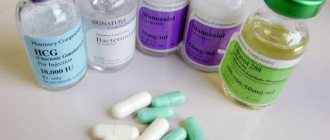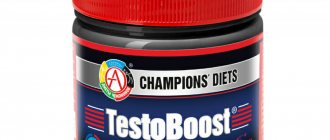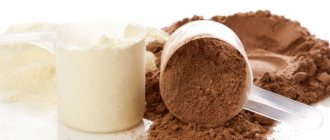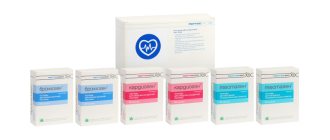Creatine and fat burner. Bad combination
It is a well-known fact that fat burners help you lose excess weight.
Fat burner and creatine will not give you side effects if you use them at the same time. In general, creatine, due to its natural origin, can be combined with many products. However, this technique is not entirely advisable, since creatine’s main property is water retention in muscle cells. If you want to lose weight, then monohydrate is not the drug that will help you with this. When losing weight, it is best to use a fat burner separately from creatine. The simultaneous use of two drugs interferes with the action of each other, or rather leads to meaningless use. You can first take a course of a fat burner, and then start taking creatine. L-carnitine is known to be taken to increase endurance and improve fat burning. On the one hand, carnitine has nothing to do with muscle tissue, so you can take two drugs calmly. But again the question arises as to the appropriateness of such a combination. There will be no side effect from such a duet, however, there will be no effective result either. Therefore, decide for yourself what is more important to you at the moment: burn fat or increase strength. By the way, l-carnitine combines better with carbohydrates and not with creatine.
Side effects from taking creatine monohydrate
It has already been said that creatine monohydrate as such does not cause harm to the body. However, it may cause side effects. I must say that this happens extremely rarely.
Side effects occur only in 4 cases out of 100. Most often this happens if additional substances are included in the composition of creatine monohydrate. They are the ones that cause side effects.
This manifests itself as follows:
- swelling occurs;
- dehydration appears;
- there are problems with digestion;
- I'm worried about cramps.
Although side effects are very rare, they do occur. This is also a reason to give preference to the product in its pure form, in which there are no impurities in the composition. This will help avoid side effects.
Functions of creatine
We are not the first to ask this question. In particular, Anthony Almada, in 1994, just conducted research that proved that the positive increase in “dry” mass due to creatine is significant, and the extra kilo of liquid is also blown away, just as it appears during a pause in cyclic intake. In addition, the scientist and his followers, in the course of further experiments, also discovered the potential effect of the drug on enhancing the productivity of training. In principle, this is a logical fact, given that, as a component of skeletal muscles, it affects energy exchange in muscles and nerve tissues.
What benefits does creatine monohydrate provide during cutting and other forms of this substance to athletes who use them?
An increase in power, performance, and strength indicators occurs due to an increase in the concentration of ATP. Of course, only within reasonable limits, this does not mean that now you can start working suddenly with heavy weights, but the difference will still be obvious. By the way, this also helps to increase “dry” mass, because muscles can work in an enhanced mode, contracting to their peak capabilities.
Improvement in relief is a contradictory, but still a fact. Many athletes like the hydration effect of the supplement on muscle cells, which significantly increases their size. The muscles seem fuller, rounder, more pumped up. And although, at Mr. Olympia, the jury may not perceive this fact as a victory, your body will certainly become the object of envy and desire on the beach.
By the way, again, it has been experimentally proven that muscle hydration enhances protein synthesis and inhibits its breakdown.
Buffering of lactic acid is one of the most pleasant aspects that creatine supplementation provides during cutting for athletes who practice intense strength training.
Stimulation of the production of anabolic hormones - somatotropin, testosterone, insulin, suppression of myostatin, in response to load training.
In addition, by taking creatine, you reduce:
Cholesterol
Level of inflammatory reactions
Risk of developing neuromuscular disorders
Consequences of cardiovascular diseases
And there can’t even be any doubt whether vegetarians need creatine when cutting. Of course, this option in the form of a supplement is the most optimal for them, since by refusing meat, they are actually deprived of one of the most valuable sources of this substance, and, accordingly, they lower their athletic capabilities several levels down at once, without using the body’s full potential.
So, material No. 1 (you can call it “Creatine production, version for dummies”☺):
By Chris Belanger
Many bodybuilders are not aware of how the creatine found in sports nutrition products is produced. They have no idea whether they make it from natural or synthetic raw materials. I will reveal this secret a little for them.
Naturally, our body produces creatine from a combination of three amino acids - glycine, arginine and methionine. Creatine is also found in animal foods, but extracting enough creatine from them for commercial use is very impractical, the product would be too expensive (note: although in the early days after the discovery of creatine, it was produced as a supplement from meat).
This begs the question: where does the creatine we use as a supplement come from? It is produced synthetically, from two chemicals - sarcosine and cyanamide (not to be confused with the similar-sounding poison cyanide). Although these substances cannot be called natural, their reaction results in a product that is absolutely suitable for human consumption: creatine. The reaction of sarcosine and cyanamide with a certain amount of water inside a special enamel container (reactor) is the method for producing synthetic creatine.
To illustrate how chemicals can be combined to produce a product fit for human consumption, let's look at common table salt. The sodium and chlorine that it consists of are completely impossible to consume in their original form. The same chlorine is extremely poisonous, it was even used as a chemical weapon during the First World War. But as a result of a chemical reaction from chlorine and sodium, we get a new harmless food component - traditional table salt.
The production process of creatine monohydrate occurs in 4 stages:
- Chemical reaction
- Cleaning
- Drying
- Grinding
Upon completion of these steps, creatine monohydrate is ready for packaging.
Original source of material
Material No. 2: fragment of the book “Creatine and Creatine Kinase in Health and Disease”, 2008.
Authors of the book chapter used: Ivo Pischel, Thomas Gastner
Among the many methods for the synthetic production of creatine monohydrate described in the literature to date, only a few can be applied to the industrial production of this dietary supplement in large volumes. All technical processes described here are based on guanylation (more precisely, amidinization) of the amino acid sarcosine or its salts (sarcosinates).
Cyanamide, O-Methylisourea (O-MethylIsoUrea) or S-Methylisothiourea (S-MethylIsoThioUrea) salts can act as agents for the guanylation process. An interesting point is that for the commercial production of creatine in Western countries (Europe and the USA), cyanamide is mainly used, while in the East (Japan and China) O-MethylIsoUrea and S-MethylIsoThioUrea salts are mainly used.
Chemical methods for the synthesis of creatine.
Creatine production method described by Strecker and Volhard (1868):
Strecker and Volhard discovered that creatine could be produced by the reaction of cyanamide and sacrosinates, using water as an inexpensive solvent (the reaction is described in the picture above). The raw materials for this process are already available in the chemical industry. Sodium and potassium sarcosinates are produced industrially by the reaction between methylamine, formaldehyde and sodium or potassium cyanide, respectively. Cyanamide is obtained from calcium cyanamide, which is made available commercially by nitriding calcium carbide (a reaction known as the Frank-Caro process since 1900).
Synthesis of creatine from sodium sarcosinate and cyanamide:
The advanced creatine production process can be schematically described as follows:
- An aqueous solution of sodium sarcosinate is poured into the reactor
- Then acetic acid is added (with intensive cooling), intensive mixing is performed, the pH level is brought to 10
- The resulting mixture is heated to 80C
- After this, an aqueous solution of cyanamide is added little by little, while stirring
- Upon completion of the reaction, the mixture is cooled to 30C, creatine crystals are separated using a filter or centrifuge
- Separated creatine is dried in vacuum at temperatures up to 100C
- Dried creatine is ground into a fine powder
Further in the book, other methods of creatine synthesis patented in various countries (apparently less common) are also mentioned. Below we present illustrations from the book that give an idea of the chemical reactions used in the production of creatine monohydrate involving sarcosine and the sulfates MethylIsoUrea and MethylIsoThioUrea.
Synthesis of creatine from sodium sarcosinate and O-MethylIsoUrea sulfate:
Synthesis of creatine from sodium sarcosinate and O-MethylIsoThioUrea sulfate :
Liked? Share with your friends!
How to take for weight loss
There are certain dosages regarding the use of creatine monohydrate for the purpose of losing weight. Don’t think that such a supplement will only build muscle mass! Correctly determining the daily dosage of the substance for men, women and girls will significantly increase their endurance, allow them to perform workouts with greater impact and, therefore, speed up the process of burning fat.
For girls and women
The problem for the fair sex is that even when losing weight, they do not “give all their best” in training. This happens due to natural restraining factors - by nature, women/girls have an instinct for self-preservation and maintaining health.
Therefore, at a certain point in the training, the body “turns on” restrictions and the woman/girl is not able to perform all the necessary loads. That is why it is advisable for them to take 4 g of creatine monohydrate per day.
It should be understood that body weight is unlikely to begin to decrease actively and immediately. Most likely, this indicator will remain the same or move downward, but not significantly. And this is due to the ability of creatine to accumulate fluid in the body.
Experts recommend that women not pay any attention to this nuance when losing weight - after a course of intense training lasting 1-2 months while taking creatine monohydrate, you can quickly get rid of edema.
For men
Men can train intensively on their own while losing weight, but it is the substance in question that will help speed up the process of forming a sculpted body. Representatives of the stronger half of humanity can take 5 g of creatine supplements daily for 2-3 months. But there is a more complex scheme:
- for the first 5 days, take 20 g of the supplement per day,
- each subsequent day, starting from 6, the dosage is reduced by 1 g,
- minimum daily dose – 4 g.
Some doctors believe that only those people who have been involved in sports for a long time and intensely should use supplements with creatine monohydrate. It is generally useless for weight loss and may even be harmful to health. However, this is only a version - the effect of creatine on the processes of building muscle mass and losing weight is still being studied.
Watch this video on how to take creatine:
https://youtube.com/watch?v=L6Lrw6G-JjE%27
The second scheme is with the loading stage
How to take creatine for loading mass gain:
- The first 4-6 days: 5 g 4 times a day. On days with physical activity, one dose should be after training, on the rest - between meals. After 4-6 days, creatine levels in the muscles stop increasing. Therefore, you can move on to the support stage.
- After a week, reduce the dosage to 2 g. There is no need to divide it into several doses. On physical activity days, take after training, and on rest days, take in the morning.
The course is shorter than in the case of the no-load scheme. It lasts 1 month, after which you again need to stop for 3-4 weeks.
Precautions for use
Using creatine as a sports supplement has a number of points to consider:
- be sure to take the drug cyclically, i.e. you should take breaks in courses;
- You should not exceed the dosage of the drug and prescribe maximum doses for yourself for the “best” effect, since the body at very high doses will stop producing creatine on its own;
- increasing the dosage leads to addiction, which hinders progress in training and strength indicators;
- do not take the drug on an empty stomach - this way you can cause indigestion and mistakenly take it for intolerance to the creatine supplement;
- pregnancy is not a strict contraindication for use, but you should definitely consult a doctor, as well as for the lactation period;
- Taking the drug at the age of 50+ may cause a slight increase in blood pressure, so women in this age group should closely monitor their health.
Instructions for use
Scheme
There is a loading reception scheme (the so-called loading) and a classic one.
Loading
After the period expires, return to the loading phase or rest for a month.
Classic regimen
3 g daily for a month, then a month of rest.
If earlier experts recommended drinking creatine supplements according to a loading scheme, then recently there have been increasingly frequent calls to give preference to the classics.
How much to take
There is no definitive answer on how much creatine to take per day. There have been no cases of overdoses, so no one can say the upper limit. It is believed that muscles are simply not able to absorb more than 30 g per day. But 30 g is too much. The most correct option is to follow the instructions included with the drug. The dosages indicated in it can be adjusted only with the permission of a trainer or doctor!
For comparison, what intake of creatine monohydrate is recommended by different manufacturers.
Ultimate Nutrition (Creatine Monohydrate)
Single dose: 1 tsp. (=5 g).
What to dissolve in: 150 ml of water, grape or apple juice.
How often: 4 times a day for 5 days. Next - 1-2 times a day.
Course: 1 month. You can repeat in a week.
Optimum Nutrition (Creatine Monohydrate)
Single dose: 2 capsules (=5 g).
What to drink with it: add to gainers or energy drinks.
How often: 4-6 times a day for 5 days. Next - 2 times a day, 1 capsule.
When to take
There is no clear answer to the question of when exactly to take a creatine supplement - before or after a workout. On the one hand, use before class is justified. This technique will supply the body with the necessary energy to increase the effectiveness of the upcoming loads. On the other hand, knowing about the restorative properties of this acid, nothing prevents you from drinking the drug immediately after training. This will help relieve stress from the body and speed up regeneration processes.
There are even manufacturers who prescribe in the instructions the possibility of using their product during the training process in order to perk up when your strength is running low and extend the time.
Here you should proceed from what is more important for the student. If you have energy, drink before training (half an hour before) or during. If muscle recovery - after. The method of application will also play an important role. For example, it is inconvenient to carry a jar of powder with you, because you do not always have liquid on hand to dilute it. And other forms of creatine are not as concentrated and effective.
One important recommendation: do not take creatine dietary supplements at night, as they have a small but still energetic effect, increasing performance. This can lead to insomnia or restless, interrupted sleep.
First scheme - without loading
Creatine is a type of sports nutrition that is effective even when taken without loading. The results of the research showed that taking 3 g per day and taking 20 g in the first 6 days followed by taking a dose of 2 g per day gives exactly the same results.
According to this scheme, you need to consume 5-6 g daily. A higher dosage will not bring better results, since the body absorbs no more than 50 mg per 1 kg of body weight. Excess substances are eliminated naturally.
On training days, the supplement is taken after training, additionally adding:
- protein,
- gainer,
- amino acids (at least 5 g).
Here we recommend studying the combination of creatine with other supplements: “Creatine with the transport system: what is it and why is it better than regular creatine.”
On normal days, use in the morning, again together with transport systems. You can also drink the powder with juice. The duration of the course is 2 months, then there should be a break of 3-4 weeks.
If creatine hydrochloride is used, its dose can be reduced to 1 g per day. This form has increased solubility and absorption, which explains the dose reduction. This form also does not provoke typical negative reactions in relation to the gastrointestinal tract and does not burden the kidneys and liver, which is typical for loading when using monohydrate.
What it is
From a biochemical point of view, creatine is a nitrogen-containing carboxylic acid present in vertebrate organisms and is actively involved in the energy metabolism of muscle and nerve cells. In some sources it may be listed as 2-(methylguanidino)-ethanoic acid. Since it was first isolated from skeletal muscle, it was given a name that goes back to the ancient Greek “κρέας”, which translates as “meat”.
This is one of the vital nutrients for the body, which rightfully ranks with proteins, fats, carbohydrates, vitamins and minerals. Its synthesis involves:
- aminoacetic acid (glycine);
- 2-amino-5-guanidinepentanoic acid (arginine);
- methionine (α-amino acid);
- enzymes: glycine amidinotransferase, guanidine acetate methyltransferase, methionine adenosyltransferase;
- creatine phosphoric acid (phosphocreatine, creatine phosphate);
- creatine phosphokinase (creatine kinase).
Enzymes that promote creatine synthesis work primarily in the liver, pancreas and kidneys. Therefore, creatine is produced in these organs, after which it is transported through the bloodstream into muscle tissue. About 95% (about 100-140 g in total in the body) is found in skeletal muscles.
It is an ergogenic component of many supplements that are produced as sports nutrition. The main indications for taking it in this status are increasing strength, increasing endurance, and building muscle mass. It is in great demand, as its effectiveness and safety for health have been scientifically proven and confirmed by a large number of studies.
Chemical formula: C₄H₉N₃O₂.
Structural formula:
Does creatine cause baldness?
Not long ago, there were rumors that creatine helps increase levels of dihydrotestosterone, a more powerful androgen that is involved in energy production (good), and also contributes to hair loss in certain categories of men and the development of prostate cancer (bad). Those with plenty of hair on their heads need not worry about an increase in dihydrotestosterone levels, but people prone to baldness may actually feel the rate of baldness increase when taking creatine supplements. At the same time, speaking about baldness and its connection with creatine supplements, it is worth noting that no clinical studies have been conducted on this topic. And even though dihydrotestosterone itself is the enemy of hair follicles, creatine accumulated in them in this situation performs a protective cellular function. The specific effect of creatine supplements on men prone to hair loss has not been studied.
It is logical to assume that creatine negatively affects the rate of baldness, but how and how negatively is unclear.
Myths about the side effects of creatine
There are many myths associated with the substance in question; many people mistake it for a harmful steroid, but this is not true at all! This is a natural substance that, even when consumed in large quantities, does not cause harm to health. In addition, scientists and doctors have successfully debunked other myths about creatine:
- negatively affects the kidneys - if this paired organ is healthy, then it is not exposed to harmful effects even with long-term use of supplements,
- periodic muscle cramps occur - during scientific experiments it was found that creatine helps to eliminate this syndrome.
It is reliably known that carboxylic acid:
- not addictive
- does not have a harmful effect on the heart,
- does not provoke infertility,
- does not affect potency,
- does not have carcinogenic effects.
Creatine monohydrate during weight loss can only be used by those people who are actively involved in sports. In this case, proper use of the supplement will speed up the process of burning fat deposits and help shape the body by building muscle mass.
What is creatine
This is a substance that is a nitrogen-containing compound. In the field of food biochemistry it is known as non-protein nitrogen. The body can get creatine from food (meat and fish) or produce it independently with the help of the liver and kidneys from amino acids (arginine, glycine and methionine). It is worth noting that most of the beneficial substances contained in food are destroyed during its preparation. For this reason, bodybuilders need to take special supplements that help build muscle mass.
Properties
Creatine monohydrate is a protein that is characterized by an anabolic effect. According to Wikisport, it helps build muscle and increase body weight, both for men and women. Some athletes claim that this supplement provides effective protection against neurological diseases. Other benefits of creatine:
- promotes rapid recovery after training;
- improves performance;
- has a beneficial effect on brain function;
- Helps the body produce ATP (adenosine triphosphate).
Action
The supplement has a complex effect on the body. When performing high-intensity exercise, its main role is to increase phosphocreatine stores in the muscles. This substance helps the body produce more ATP, which is the main source of energy. Many people believe that they need to take creatine for weight loss, but in this case it is not very effective. However, the drug saturates the body with protein, thanks to which the athlete is able to train with double strength . Creatine supplements also help:
- increase endurance;
- increase the number of anabolic hormones (IGF-1);
- hydrate cells (increase their water content);
- reduce protein breakdown in tissues;
- lower myostatin levels.
Contraindications
For years, athletes have avoided taking creatine monohydrate due to side effects. The use of the supplement was believed to cause the following harm:
- it causes dehydration;
- disrupts the water-salt balance;
- promotes gastrointestinal disorders;
- has a negative effect on the kidneys and liver;
- causes hyperemia (overflow of blood vessels).
Over the past ten years, studies have been conducted on innovative equipment that have not been able to confirm these rumors. The only side effect of creatine is weight gain (due to increased water concentration inside cells). For many athletes who want to create a beautiful body contour, this is what they need. However, it is worth noting that when losing weight, this fact can serve as an obstacle.
Creatine when cutting. Creatine for cutting
To achieve their goals, athletes take various sports supplements. Amateurs who want to get rid of excess fat most often use creatine. Its benefit lies not only in stimulating the growth of lean muscle mass without fat, but also in the fact that thanks to the supplement, endurance and strength levels increase.
Creatine, as a rule, is used during periods of muscle gain, but those who are drying also drink the supplement. Beginners who have recently started training and have no experience with taking sports supplements are interested in the question of whether it is possible to take it during the period of building up their relief.
Is it possible to take creatine while losing weight?
Research shows creatine's ability to retain water in the body. The fat burning process does not change after taking the supplement, but the accumulated fluid prevents the formation of relief.
The reasons why creatine is taken while cutting is that the supplement:
- increases endurance during training, and, therefore, allows you to burn more calories;
- helps increase strength during the drying period, which allows you to continue training and withstand loads when the changed diet cannot replenish energy;
- promotes the growth of muscle mass without fat, which is almost impossible to do without taking creatine, since you cannot lose weight and gain muscle at the same time, but the supplement minimizes volume loss.
There is only one downside to creatine - the supplement retains fluid in the muscles. This drawback is of importance only for those who are preparing to perform in competitions. For athletes who want to get rid of excess fat, that is, to get lean, this aspect is insignificant. The water will go away immediately after stopping creatine.
How to properly take creatine while cutting
The supplement is available in a variety of forms. The most effective is monohydrate. It is recommended to use it both during cutting and during the period of gaining muscle mass. The daily intake of the supplement is 5 grams.
This is not the only way to take creatine. It can be consumed using a load, when the first five days you take 20 grams, and then reduce the rate to 3-4 grams. As recent scientific research has shown, the body is not able to absorb more than 5 g per day, and, therefore, drinking the supplement in large quantities is not advisable.
Creatine consumed during cutting can also be taken with other supplements. These can be amino acid complexes (it is better to choose BCAA), proteins, fat burners, pre-workouts, and so on. The supplement is not recommended to be used simultaneously with caffeine. Substances do not combine with each other, but conflict. There are exceptions, but this information should be read in a separate article.
Summarizing
Creatine is useful during the cutting period and helps you continue to train and maintain strength. The supplement stimulates the process of fat burning while preserving muscle mass, which is simply impossible to do without taking the drug. In addition, thanks to creatine, performance during exercise improves. It should be borne in mind that when weighing, the results are practically or completely invisible. This is due to water retention, but after stopping creatine, when the fluid is gone, the effect of the lost fat will be reflected in weight.
Effect on the body
Why does a CrossFit athlete need creatine monohydrate:
- Reduces injuries. This is achieved by increasing fluid in the body.
- Increases strength endurance. The sensitivity of muscles to oxygen increases, which allows the foreman
- Increases muscle mass by infusing water and increasing the volume of work during training.
- Increases glycogen levels.
- Improves the body's ability to perform anaerobic glycolysis.
- Improves pumping. By increasing the force of heart contractions during intense work, the heart pumps blood faster into the muscles.
The effect of creatine monohydrate is to provide maximum saturation of muscles with essential amino acids. With strong saturation, the following processes occur in the body:
- Binding of water molecules in muscle tissue.
- Improving the contractility of the heart muscle. When enough amino acid accumulates in the muscles, it dilates the blood vessels leading to the heart valve. As a result, the saturation of the heart with blood increases, the strength of contractions increases without increasing heart rate. Cells and tissues receive oxygen in fewer hits.
- Improving strength endurance by increasing the amount of oxygen in the muscles.
All this leads to improved performance of the athlete. But it is not creatine itself that increases muscle mass, but the athlete’s ability to make a sharp jump in the progression of loads without overtraining.
Important: unlike other nutrients, it is advisable to consume creatine exclusively in the form of a sports supplement, since the concentration of the substance in natural food is very low. For example, red fish contains only 0.1 g of creatine per 100 g of product. And to maintain normal performance, an athlete’s body needs about 10 g per day.
What benefits does creatine monohydrate provide to the modern athlete? On average, this is an increase in dry mass by 1-2%, an increase in weight due to liquid by 5-7% and an increase in strength indicators by 10%. Is there a rollback effect? Yes! In the case of a decrease in creatine concentration, the rollback reaches 40-60% of peak performance.
What do we know about creatine and what is it for?
Since creatine is actively used by athletes, it means it really works. And here are the positive effects it has:
- Increase in strength indicators.
When an athlete performs exercises that require special energy expenditure, the need for a nucleotide such as adenosine triphosphate increases sharply. It is a universal source of energy. In order for muscles to work as hard as possible, the supply of ATP must be constantly replenished. How can this be done? That's right, adding creatine as a food supplement. After this, the level of adenosine phosphate nucleotide will be normal, and the endurance and strength of muscle tissue will increase.
Increased muscle volume.
Bodybuilders know that with the help of creatine they can increase their strength, since the volume of muscle tissue increases with proper intake of the substance. It often happens that dry mass increases by several kilograms. And this is in just thirty days of admission! This is simply an excellent result! The main thing is to focus on a balanced diet and regularly visit the gym. Recent research has shown that an athlete can increase athletic performance in just a week of taking creatine! However, this is more the exception than the rule. The main thing here is that the body is highly sensitive to creatine.
Improving muscle definition.
Creatine is directly involved in giving muscles relief. It helps fill cells with water, which is the basis. Externally, well-hydrated muscles look more attractive and powerful.
The positive qualities of creatine do not end there.
It helps reduce bad cholesterol levels, has an anti-inflammatory effect, and protects the central nervous system from disorders.
Doctors prescribe protein when it is necessary to relieve the patient from diseases that provoke muscle disorders. It is actively prescribed for heart surgery, as it has been shown to reduce cardiac arrhythmias.
Creatine for gaining muscle mass
Creatine is the most effective supplement for increasing muscle size. To get results as quickly as possible, you need to eat right, and also work out the training process down to the smallest detail. You won’t be able to get the effect by simply taking creatine, just like any other amino acid. When taking the substance, it is imperative to add more vitamins, minerals, protein and other components to the diet, as the need for them will increase. It is also necessary to normalize your sleep patterns. It is recommended to sleep at least eight hours so that the body is well rested after exhausting workouts.
When taken correctly, creatine can not only increase muscle gain. Endurance increases and mood improves. What else do you need for inspiration and the desire to lift more weight? In addition, the amount of lactic acid in the muscles is reduced, and the hydration of muscle cells improves.
Method of use and dosage of supplement for muscle growth in powder and capsules
How much substance do you need on training days?
On strength training days, creatine should be taken after exercise. For quick absorption, the product can be combined with protein shakes, gainers, amino acids, or simply washed down with sweet juice. Dosage – at least 5 grams.
Doses on rest days
On break days, the supplement should be taken directly in the morning. It will make up for the energy deficit in the muscles that was spent at night for the recovery process. Serving – 3-6 grams.
How to drink creatine correctly with the transport system: features of the drugs
A transport system supplement involves a combination of creatine and additional substances that improve its absorption and accelerate transport into muscle fibers. For example, a product with good reviews is ESM Transport (1400 g). In addition to the transport function, additional ingredients have their own effect - an anabolic effect, increasing the rate of muscle nutrition, etc.
One of the most powerful complexes with a transport system on IHERB:
Universal Nutrition, Animal Pump, Muscle Builder, Pre-Workout, 30 Packs
Price – RUB 3,186.26
Buy from a partner
Such supplements have specific features regarding the time and frequency of administration. It is best to drink creatine with the transport system before training. This complex contains active substances that quickly nourish the body before physical activity.
Note! This recommendation is general: for accurate information, read the manufacturer's instructions.
See other articles on the topic:
What creatine to use for maximum effect: capsules, powder, tablets, liquid form
How much creatine to take daily?
How to take creatine capsules: general rules
How to take creatine powder correctly
How and in what to dilute the drug: is it possible in hot water, milk?
The additive should be diluted in juice (for example, grape juice) or warm water with added sugar. Glucose from the drink will allow the substance to be better absorbed and begin to act faster.
Is it possible to breed in hot water? The liquid for preparing the additive should be slightly warm, but not scalding in temperature. Boiling water will simply spoil creatine and reduce the benefits of taking it to a minimum.
Bodybuilders are interested in whether they can take the supplement with milk while gaining weight. If you are not allergic to lactose, creatine can be mixed with milk of any fat content (this can improve the absorption process and the number of calories received).
See other articles on the topic:
Shelf life and storage of creatine
What to drink creatine monohydrate with: the best combinations
How many carbohydrates should you consume after creatine?
Creatine works most effectively when paired with carbohydrates, so taking a gainer or carbohydrate products with this acid is completely justified.
How much carbohydrates you need to consume after consuming creatine depends on the dose, the ratio should be 35 to 5.
Can I drink coffee while taking creatine?
Creatine supplements and natural caffeine can improve training performance when taken independently. When combining them, the effect may be enhanced, but this phenomenon has not received practical confirmation in research.
Note! It is believed that both components can contribute to dehydration. Maintain an optimal drinking regimen when combining supplements.











